III. Monetary and Liquidity Conditions - ಆರ್ಬಿಐ - Reserve Bank of India
III. Monetary and Liquidity Conditions
Monetary Survey
Monetary and liquidity conditions remained largely comfortable during 2005-06 although there was some tightness in liquidity conditions during the last four months of 2005-06 reflecting partly the impact of the redemption of India Millennium Deposits (IMDs). The Reserve Bank, therefore, injected liquidity through unwinding of the Market Stabilisation Scheme (MSS) and repo operations under the liquidity adjustment facility (LAF) along with some private placement of the Central Government securities. As a result, the banking system was able to meet the sustained pick-up in credit demand from the commercial sector. However, in the face of the rising demand for commercial credit, banks restricted their incremental investments in Government paper. Strong growth in deposits as well as access to non-deposit sources also enabled the banking system to meet the enhanced demand for commercial credit. Liquidity injecting operations of the Reserve Bank led to a rise in its net domestic assets (NDA) and a higher order of expansion of reserve money during 2005-06. Concomitantly, the year-on-year (y-o-y) broad money (M3) growth as on March 31, 2006 – at 16.2 per cent – was above the indicative growth of 14.5 per cent projected in the Annual Policy Statement in the beginning of the year (April 2005). In this context, it may be noted that data on fiscal year variation for 2005-06 are not comparable with those of the previous years as the data for 2005-06 include 27 fortnights while usually the data for a year include 26 fortnights. Moreover, the last reporting Friday of 2005-06 coincided with March 31, the closing day for banks’ accounts, thereby giving rise to the phenomenon of year-end bulge in aggregate deposits and credit (Table 20). Expansion in the new monetary aggregate (NM3) was higher than M3 on account of net outflows under foreign currency deposits, reflecting redemption of IMDs. Based on the recommendations of the Working is compiled on a Group on Money Supply (Chairman: Dr. Y.V. Reddy), NM3
residency basis by not directly reckoning banks’ non-resident repatriable foreign currency fixed deposits such as the balances under the FCNR (B)
scheme and IMDs. Expansion in liquidity aggregates (L1, L2 and L3) was also
higher than a year ago. Liquidity aggregates encompass select liabilities of the postal savings, financial institutions and NBFCs in addition to that of the banking sector.
Demand for currency recorded a higher growth during 2005-06, in consonance with acceleration in economic activity. Currency demand generally
|
Table 20: Monetary Indicators |
|||||||||||||
|
(Amount in Rupees crore) |
|||||||||||||
|
Item |
Outstanding |
Variation |
|||||||||||
|
as on |
|||||||||||||
|
Fiscal year |
Year-on-year |
||||||||||||
|
March 31, |
|||||||||||||
|
2006 |
2004-05 |
2005-06 |
As on |
As on |
|||||||||
|
April 1, 2005 |
March 31, 2006 |
||||||||||||
|
Amount |
Per cent |
Amount |
Per cent |
Amount |
Per cent |
Amount |
Per cent |
||||||
|
1 |
2 |
3 |
4 |
5 |
6 |
7 |
8 |
9 |
10 |
||||
|
I. |
Reserve Money |
5,73,043 |
52,623 |
12.1 |
83,907 |
17.2 |
58,998 |
14.2 |
98,399 |
20.7 |
|||
|
II. |
27,09,905 |
2,42,260 |
12.1 |
4,58,456 |
20.4 |
2,84,284 |
13.9 |
3,77,238 |
16.2 |
||||
|
Broad Money (M3) |
|||||||||||||
|
a) |
Currency with the Public |
4,14,404 |
40,892 |
13.0 |
58,541 |
16.5 |
39,894 |
12.7 |
59,533 |
16.8 |
|||
|
b) |
Aggregate Deposits |
22,88,587 |
2,00,009 |
11.9 |
3,99,479 |
21.1 |
2,42,443 |
14.1 |
3,17,111 |
16.1 |
|||
|
i) |
Demand Deposits |
3,87,877 |
26,528 |
10.3 |
1,02,723 |
36.0 |
43,585 |
15.7 |
66,514 |
20.7 |
|||
|
ii) |
Time Deposits |
19,00,710 |
1,73,481 |
12.2 |
2,96,757 |
18.5 |
1,98,857 |
13.7 |
2,50,597 |
15.2 |
|||
|
of which: Non-Resident |
|||||||||||||
|
Foreign Currency Deposits |
58,976 |
802 |
1.1 |
-17,429 |
-22.8 |
2,049 |
2.8 |
-17,175 |
-22.6 |
||||
|
III. |
27,28,782 |
2,44,300 |
12.5 |
4,85,608 |
21.6 |
2,85,894 |
14.3 |
4,02,321 |
17.3 |
||||
|
NM3 |
|||||||||||||
|
of which: Call Term Funding |
|||||||||||||
|
from Financial Institutions |
83,681 |
9,678 |
39.2 |
14,158 |
20.4 |
11,077 |
43.2 |
11,761 |
16.4 |
||||
|
IV. |
a) |
28,30,903 |
2,61,559 |
12.9 |
4,99,082 |
21.4 |
2,61,559 |
12.9 |
4,99,082 |
21.4 |
|||
|
L1 |
|||||||||||||
|
of which: Postal Deposits |
1,02,121 |
17,259 |
24.2 |
13,474 |
15.2 |
17,259 |
24.2 |
13,474 |
15.2 |
||||
|
b) |
28,33,835 |
2,57,437 |
12.6 |
4,99,891 |
21.4 |
2,57,437 |
12.6 |
4,99,891 |
21.4 |
||||
|
L2 |
|||||||||||||
|
of which: FI Deposits |
2,932 |
-4,122 |
-66.0 |
809 |
38.1 |
-4,122 |
-66.0 |
809 |
38.1 |
||||
|
c) |
28,55,529 |
2,57,555 |
12.5 |
5,01,745 |
21.3 |
2,57,555 |
12.5 |
5,01,745 |
21.3 |
||||
|
L3 |
|||||||||||||
|
of which: NBFC Deposits |
21,694 |
118 |
0.6 |
1,854 |
9.3 |
118 |
0.6 |
1,854 |
9.3 |
||||
|
V. |
Major Sources of Broad Money |
||||||||||||
|
a) |
Net Bank Credit to the |
||||||||||||
|
Government (i+ii) |
7,77,526 |
1,670 |
0.2 |
20,760 |
2.7 |
6,776 |
0.9 |
28,819 |
3.8 |
||||
|
i) |
Net Reserve Bank Credit |
||||||||||||
|
to Government |
12,617 |
-62,882 |
30,592 |
-50,941 |
40,280 |
||||||||
|
of which: to the Centre |
12,573 |
-60,177 |
35,830 |
-50,813 |
40,787 |
||||||||
|
ii) |
Other Banks’ Credit to |
||||||||||||
|
Government |
7,64,909 |
64,552 |
9.2 |
-9,833 |
-1.3 |
57,717 |
8.2 |
-11,460 |
-1.5 |
||||
|
b) |
Bank Credit to Commercial Sector |
16,86,509 |
2,31,216 |
22.8 |
4,06,260 |
31.7 |
2,54,035 |
24.3 |
3,55,251 |
26.7 |
|||
|
c) |
Net Foreign Exchange Assets of |
||||||||||||
|
Banking Sector |
7,13,865 |
1,22,669 |
23.3 |
64,610 |
10.0 |
1,18,428 |
22.4 |
65,962 |
10.2 |
||||
|
Memo Items: |
|||||||||||||
|
Scheduled Commercial Bank’s |
|||||||||||||
|
Aggregate Deposits |
20,87,670 |
1,92,269 |
12.8 |
3,87,471 |
22.8 |
2,30,214 |
14.8 |
3,02,534 |
16.9 |
||||
|
Scheduled Commercial Bank’s |
|||||||||||||
|
Non-food Credit |
14,54,687 |
2,21,602 |
27.5 |
3,95,379 |
37.3 |
2,41,433 |
28.8 |
3,42,493 |
30.8 |
||||
|
FIs : Financial Institutions. NBFCs : Non-Banking Financial Companies. NM3are liquidity aggregates compiled on the recommendations L1=NM3+ All deposits with the post office saving banks (excluding National
Saving Certificates) L3=L2+ Public deposits of non-banking financial companies. |
|||||||||||||
exhibited the usual intra-year seasonal pattern, typically increasing during festival seasons and the initial part of the month (Chart 17).
Aggregate deposits accelerated during 2005-06, led by both demand and time components. Growth rate of demand deposits exceeded that of time deposits
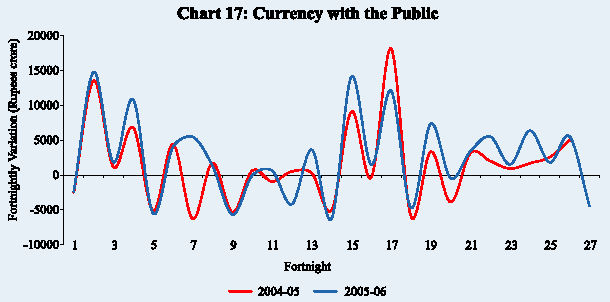
and accordingly, there was a rise in the contribution of demand deposits in growth of broad money (Chart 18). Demand deposits expansion mirrored the sustained pick-up in non-food credit and a buoyant primary capital market, with funds getting temporarily parked in demand deposits (Table 21).
Scheduled commercial banks’ time deposits growth at 16.1 per cent (y-o-y) as on March 31, 2006 was higher than that recorded a year ago (14.6 per cent; net of the conversion effect) reflecting higher interest rates as well as the base effect. The slowdown in time deposits in January 2006 reflected the one-shot repayment of the proceeds under India Millennium Deposits (IMDs). Concomitantly, mobilisation under small savings schemes decelerated to 15.7 per cent by end-February 2006 from a peak of 23.3 per cent in December 2004. Thus, the growth rate of small savings,
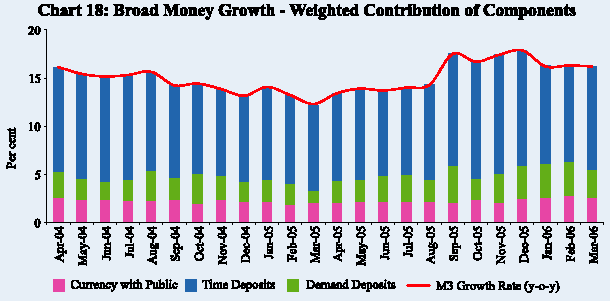
|
Table 21: Monetary Aggregates - Variations |
|||||||||||
|
(Rupees crore) |
|||||||||||
|
Item |
2004-05 |
2005-06 |
2004-05 |
2005-06 |
|||||||
|
Q1 |
Q2 |
Q3 |
Q4 |
Q1 |
Q2 |
Q3 |
Q4 |
||||
|
1 |
2 |
3 |
4 |
5 |
6 |
7 |
8 |
9 |
10 |
11 |
|
|
M3 (=1+2+3 = 4+5+6+7-8) |
2,45,773 |
4,58,456 |
69,831 |
16,999 |
53,458 |
1,05,485 |
1,08,666 |
1,23,864 |
45,215 |
1,80,711 |
|
|
(2,42,260) |
(49,945) |
||||||||||
|
Components |
|||||||||||
|
1. |
Currency with the Public |
40,892 |
58,541 |
14,540 |
-3,098 |
15,422 |
14,027 |
19,500 |
-10,594 |
29,901 |
19,735 |
|
2. |
Aggregate Deposits with Banks |
2,03,522 |
3,99,479 |
56,754 |
19,342 |
37,725 |
89,701 |
91,188 |
1,33,697 |
16,056 |
1,58,539 |
|
2.1 Demand Deposits with Banks |
26,528 |
1,02,723 |
-14,038 |
2,094 |
15,721 |
22,751 |
14,256 |
41,653 |
-3,173 |
49,987 |
|
|
2.2 Time Deposits with Banks |
1,76,994 |
2,96,757 |
70,792 |
17,248 |
22,004 |
66,949 |
76,932 |
92,044 |
19,229 |
1,08,553 |
|
|
(1,73,481) |
(18,491) |
||||||||||
|
3. |
‘Other’ Deposits with RBI |
1,359 |
436 |
-1,463 |
755 |
310 |
1,757 |
-2,021 |
761 |
-742 |
2,437 |
|
Sources |
|||||||||||
|
4. |
Net Bank Credit to Govt. Sector |
13,863 |
20,760 |
12,986 |
-11,798 |
-4,524 |
17,199 |
9,339 |
-3,551 |
-4,216 |
19,188 |
|
(1,670) |
(-16,717) |
||||||||||
|
4.1 RBI’s Net Bank Credit to |
|||||||||||
|
Govt. Sector |
-62,882 |
30,592 |
-34,143 |
-6,179 |
184 |
-22,744 |
9,275 |
-25,251 |
19,879 |
26,689 |
|
|
4.1.1 RBI’s Net Credit to |
|||||||||||
|
Central Govt. |
-60,177 |
35,830 |
-30,029 |
-4,499 |
203 |
-25,852 |
14,600 |
-25,251 |
19,812 |
26,669 |
|
|
4.2 Other Bank Credit to |
|||||||||||
|
Govt. Sector |
76,745 |
-9,833 |
47,129 |
-5,619 |
-4,708 |
39,943 |
63 |
21,700 |
-24,095 |
-7,501 |
|
|
5. |
Bank Credit to Commercial Sector |
2,64,098 |
4,06,260 |
38,057 |
40,093 |
1,07,789 |
78,160 |
61,245 |
114,289 |
63,713 |
1,67,013 |
|
(2,31,216) |
(74,907) |
||||||||||
|
6. |
Net Foreign Exchange Assets of |
||||||||||
|
Banking Sector |
1,22,669 |
64,610 |
49,206 |
-1,335 |
32,891 |
41,907 |
-13,378 |
24,062 |
27,701 |
26,224 |
|
|
6.1 Net Foreign Exchange Assets |
|||||||||||
|
of RBI |
1,28,377 |
60,193 |
57,525 |
-5,260 |
31,462 |
44,651 |
-14,595 |
24,823 |
23,741 |
26,224 |
|
|
7. |
Governments’ Currency |
||||||||||
|
Liabilities to the Public |
152 |
1,247 |
37 |
9 |
89 |
17 |
384 |
910 |
-100 |
54 |
|
|
8. |
Net Non-Monetary Liabilities of |
||||||||||
|
Banking Sector |
1,55,008 |
34,421 |
30,454 |
9,969 |
82,788 |
31,798 |
-51,077 |
11,846 |
41,884 |
31,768 |
|
|
Memo items |
|||||||||||
|
1. |
Non-resident Foreign Currency |
||||||||||
|
Deposits |
802 |
-17,429 |
953 |
-189 |
-654 |
692 |
550 |
-447 |
1,602 |
-19,134 |
|
|
2. |
SCBs’ Call-term Borrowing from |
44,853 |
14,158 |
5,409 |
530 |
35,464 |
3,451 |
1,395 |
7,359 |
1,836 |
3,568 |
|
Financial Institutions |
(9,677) |
(288) |
|||||||||
|
3. |
Overseas Borrowing by Scheduled |
||||||||||
|
Commercial Banks |
8,529 |
5,530 |
3,012 |
-658 |
6,267 |
-90 |
1,948 |
6,008 |
384 |
-2,809 |
|
|
Note : Figures
in parentheses are adjusted for the effect of conversion of a non-banking
entity into a |
|||||||||||
which was significantly higher than that of time deposits over the previous three years, turned out to be close to that of time deposits in 2005-06 (Chart 19).
Credit growth remained strong for the second successive year on account of acceleration in credit to commercial sector. Food credit increased by Rs.1,771 crore as on March 31, 2006 (y-o-y) – reflecting a lower order of procurement of foodgrains – in contrast to an increase of Rs.3,043 crore during the previous year. On the other hand, non-food credit growth was broad-based reflecting strengthening of economic activity. Non-food credit, on a year-on-year basis, registered a growth of 30.8 per cent as on March 31, 2006 on top of a base as high as 28.8 per cent a year ago. Despite a higher order of accretion to deposits, incremental credit-deposit ratio of SCBs remained above 100 per cent (Chart 20).
The corporate sector continued to augment its recourse to bank credit with a variety of other sources. Resources raised from ADR/GDR issuances more than doubled during April-February 2005-06 as compared with the corresponding
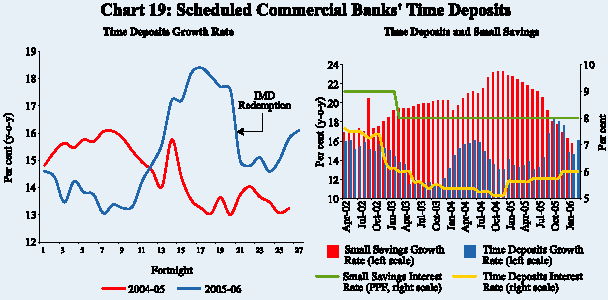
period of the previous year. Equity issuances in the domestic market were also higher during the year, benefiting from buoyancy in the secondary market. Mobilisation through issuances of commercial papers, however, was subdued and declined during the second half of the year, mainly on account of tight liquidity conditions in domestic markets. After some moderation in the first quarter of 2005-06, funds raised through external commercial borrowings (ECBs) turned buoyant. Internal sources – backed by strong corporate sector profitability – also constituted a significant source of funds for the corporate sector (Table 22).
With credit demand continuing to record strong growth and outpacing deposit growth, banks liquidated their existing investments in Government
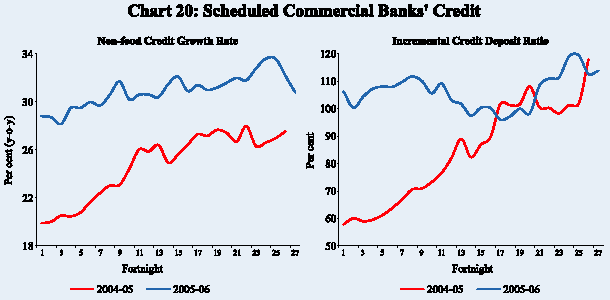
|
Table 22: Select Sources of Funds to Corporates |
||||||||||||||
|
(Rupees crore) |
||||||||||||||
|
Item |
2004-05 |
2005-06 |
2004-05 |
2005-06 |
||||||||||
|
April-February |
Q1 |
Q2 |
Q3 |
Q4 |
Q1 |
Q2 |
Q3 |
Q4^^ |
||||||
|
1 |
2 |
3 |
4 |
5 |
6 |
7 |
8 |
9 |
10 |
11 |
||||
|
A. |
Bank Credit to Industry |
35,485 # |
66,480 # |
6,636 |
11,186 |
13,733 |
21,680 |
11,148 |
28,061 |
24,484 |
2,787@ |
|||
|
B. |
Flow from Non-banks to Corporates |
|||||||||||||
|
1. |
Capital Issues * (i+ii) |
9,597 |
12,661 |
228 |
4,529 |
3,214 |
2,495 |
1,264 |
2,758 |
5,549 |
3,090 |
|||
|
i) Non-Government Public |
||||||||||||||
|
Ltd. Companies (a+b) |
6,913 |
12,288 |
228 |
4,529 |
530 |
2,495 |
1,264 |
2,758 |
5,549 |
2,717 |
||||
|
a) Bonds/Debentures |
0 |
118 |
0 |
0 |
0 |
0 |
118 |
0 |
0 |
0 |
||||
|
b) Shares |
6,913 |
12,170 |
228 |
4,529 |
530 |
2,495 |
1,146 |
2,758 |
5,549 |
2,717 |
||||
|
ii) PSUs and Government |
||||||||||||||
|
Companies |
2,684 |
373 |
0 |
0 |
2,684 |
0 |
0 |
0 |
0 |
373 |
||||
|
2. |
ADR/GDR Issues + |
2,475 |
6,445 |
770 |
597 |
872 |
721 |
789 |
739 |
3,643 |
1,274 |
|||
|
3. |
External Commercial |
|||||||||||||
|
Borrowings (ECBs) $ |
26,353 |
25,707 |
12,077 |
3,795 |
10,481 |
13,164 |
3,789 |
12,740 |
9,178 |
– |
||||
|
4. |
Issue of CPs |
5,104 ^ |
-1,542 ^ |
1,819 |
421 |
1,901 |
963 |
3,562 |
1,928 |
-2,491 |
-4,541 & |
|||
|
C. |
Depreciation Provision ++ |
14,020 |
£ |
21,227 £ |
5,504 |
5,836 |
5,731 |
6,106 |
7,137 |
7,617 |
7,748 |
– |
||
|
D. |
Profit after Tax ++ |
31,066 |
£ |
51,364 £ |
10,396 |
13,004 |
13,196 |
16,798 |
16,726 |
18,169 |
18,790 |
– |
||
|
*:Gross issuances excluding issues by banks and financial institutions.
Figures are not adjusted for banks’ |
||||||||||||||
papers as well as non-SLR securities. The gilt portfolio of commercial banks registered a decline of Rs.15,562 crore as on March 31, 2006 (y-o-y) in contrast to an increase of Rs.42,473 crore (net of the conversion effect) during the previous year. Consequently, commercial banks' holding of Government securities declined to nearly 32 per cent of their net demand and time liabilities (NDTL) as on March 31, 2006 from around 38 per cent a year ago (Chart 21). Banks also
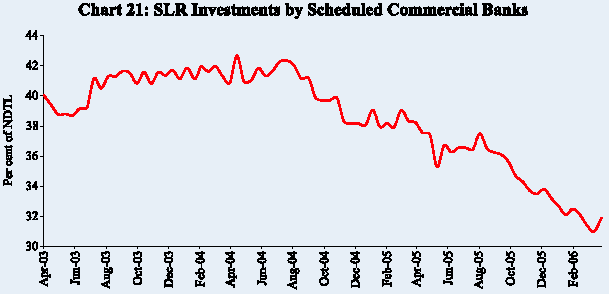
|
Table 23: Scheduled Commercial Banks’ Survey |
|||||
|
(Amount in Rupees crore) |
|||||
|
Item |
Variation (year-on-year) |
||||
|
As on April 1, 2005 |
As on March 31, 2006 |
||||
|
Amount |
Per cent |
Amount |
Per cent |
||
|
1 |
2 |
3 |
4 |
5 |
|
|
Sources of Funds |
|||||
|
I. |
Aggregate Deposits |
2,30,214 |
14.8 |
3,02,534 |
16.9 |
|
II. |
Call Term Funding from Financial Institutions |
11,077 |
43.2 |
11,761 |
16.4 |
|
III. |
Overseas Foreign Currency Borrowings |
11,712 |
69.6 |
2,657 |
9.3 |
|
IV. |
Capital and Reserves |
24,957 |
22.2 |
48,886 |
35.6 |
|
Uses of Funds |
|||||
|
I. |
Bank Credit |
2,44,476 |
27.9 |
3,44,264 |
29.9 |
|
II. |
Investments in Government Securities |
42,473 |
6.4 |
-15,562 |
-2.2 |
|
III. |
Investments in Other Approved Securities |
-2,622 |
-11.6 |
2,876 |
14.4 |
|
IV. |
Investments in Non-SLR Securities |
2,670 |
1.8 |
-12,820 |
-8.7 |
|
V. |
Foreign Currency Assets |
-3,253 |
-10.0 |
11,296 |
38.4 |
|
VI. |
Balances with Reserve Bank |
14,715 |
18.8 |
34,077 |
36.6 |
|
Note : 1.
Data are provisional. |
|||||
liquidated their non-SLR investments (i.e., investments in commercial papers, bonds and debentures) by Rs.12,820 crore. Continued access to call-term funding from financial institutions, raising of funds through equity issuances in the primary market as well as higher internal reserves also helped banks to fund credit demand (Table 23).
Reserve Money Survey
Reserve money growth at 20.7 per cent as on March 31, 2006 (y-o-y) was higher than the previous year (14.2 per cent) (Chart 22). Apart from the base
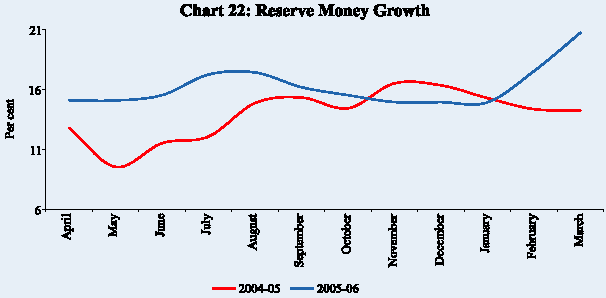
effect, the higher order of reserve money expansion reflected liquidity injection operations of the Reserve Bank during the year in the wake of higher credit demand and redemption of IMDs (Table 24).
The Reserve Bank’s foreign currency assets (net of revaluation) recorded a lower order of increase during 2005-06, partly reflecting the redemption of IMDs on December 29, 2005 out of its foreign exchange reserves. The increase in the NFEA during 2005-06 was concentrated in the three-week period during July 23 – August 12, 2005 and during February-March 2006 (Chart 23).
Mirroring the liquidity injection operations as well as private placement, the Reserve Bank's net credit to the Centre registered an increase of Rs.35,830 crore during the fiscal 2005-06 in contrast to a decline of Rs.60,177 crore during 2004-05 (Table 25). The increase during the year was mainly on account of unwinding of the balances under the MSS which led to a decline of Rs.21,954 crore in the Centre's deposits with the Reserve Bank in contrast to an increase of Rs.72,558 crore on account of large issuances under the scheme during 2004-05. Furthermore, the balances under the LAF reverse repos declined by Rs.12,080 crore during 2005-06 reflecting injection of liquidity through LAF operations. This coupled with the private placement of Rs.10,000 crore resulted in an increase
|
Table 24: Variation in Major Components and Sources of Reserve Money |
|||||||||||
|
(Rupees crore) |
|||||||||||
|
Item |
2004-05 |
2005-06 |
2004-05 |
2005-06 |
|||||||
|
Q1 |
Q2 |
Q3 |
Q4 |
Q1 |
Q2 |
Q3 |
Q4 |
||||
|
1 |
2 |
3 |
4 |
5 |
6 |
7 |
8 |
9 |
10 |
11 |
|
|
Reserve Money |
52,623 |
83,907 |
-6,812 |
-6,285 |
31,546 |
34,174 |
7,177 |
1,062 |
25,446 |
50,223 |
|
|
Components |
|||||||||||
|
1. |
Currency in circulation |
41,633 |
61,956 |
14,317 |
-4,166 |
16,467 |
15,015 |
19,877 |
-9,479 |
29,154 |
22,403 |
|
2. |
Bankers’ Deposits with RBI |
9,631 |
21,515 |
-19,665 |
-2,874 |
14,769 |
17,401 |
-10,680 |
9,780 |
-2,967 |
25,382 |
|
3. |
Other Deposits with RBI |
1,359 |
436 |
-1,463 |
755 |
310 |
1,757 |
-2,021 |
761 |
-742 |
2,437 |
|
Sources |
|||||||||||
|
1. |
RBI’s net credit to Government |
-62,882 |
30,592 |
-34,143 |
-6,179 |
184 |
-22,744 |
9,275 |
-25,251 |
19,879 |
26,689 |
|
of which: to Central Government |
-60,177 |
35,830 |
-30,029 |
-4,499 |
203 |
-25,852 |
14,600 |
-25,251 |
19,812 |
26,669 |
|
|
2. |
RBI’s credit to banks and |
||||||||||
|
commercial sector |
-833 |
535 |
-2,985 |
-740 |
3,726 |
-835 |
1,155 |
-1,869 |
101 |
1,148 |
|
|
3. |
NFEA of RBI |
1,28,377 |
60,193 |
57,525 |
-5,260 |
31,462 |
44,651 |
-14,595 |
24,823 |
23,741 |
26,224 |
|
4. |
Government’s Currency |
||||||||||
|
Liabilities to the Public |
152 |
1,247 |
37 |
9 |
89 |
17 |
384 |
910 |
-100 |
54 |
|
|
5. |
Net Non-Monetary Liabilities of RBI |
12,191 |
8,660 |
27,245 |
-5,885 |
3,916 |
-13,085 |
-10,957 |
-2,450 |
18,175 |
3,892 |
|
Memo: |
|||||||||||
|
1. |
Net Domestic Assets |
-75,754 |
23,714 |
-64,336 |
-1,025 |
84 |
-10,477 |
21,771 |
-23,760 |
1,705 |
23,998 |
|
2. |
FCA, adjusted for revaluation |
1,15,044 |
68,834 |
33,160 |
-3,413 |
29,858 |
55,440 |
5,034 |
23,665 |
11,998 |
28,137 |
|
3. |
NFEA/Reserve Money (per cent) |
||||||||||
|
(end-period) |
125.3 |
117.4 |
126.1 |
126.7 |
124.9 |
125.3 |
120.5 |
125.3 |
123.7 |
117.4 |
|
|
4. |
NFEA/Currency (per cent) |
166.2 |
156.3 |
158.8 |
159.2 |
160.7 |
166.2 |
154.0 |
164.4 |
158.4 |
156.3 |
|
NFEA : Net Foreign Exchange Assets. |
|||||||||||
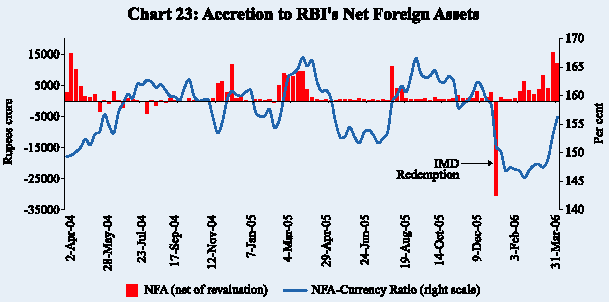
of the Reserve Bank's holding of dated securities. The increase in the Reserve Bank credit to the Centre, thus, largely reflected liquidity management operations of the Reserve Bank rather than passive financing of the Centre's fiscal gap.
|
Table 25: Net Reserve Bank Credit to the Centre - Variations |
|||||||||||||
|
(Rupees crore) |
|||||||||||||
|
Item |
2004-05 |
2005-06 |
2004-05 |
2005-06 |
|||||||||
|
Q1 |
Q2 |
Q3 |
Q4 |
Q1 |
Q2 |
Q3 |
Q4 |
||||||
|
1 |
2 |
3 |
4 |
5 |
6 |
7 |
8 |
9 |
10 |
11 |
|||
|
Net Reserve Bank Credit to |
|||||||||||||
|
the Centre (1+2+3+4-5) |
-60177 |
35,830 |
-30,029 |
-4,499 |
203 |
-25,852 |
14,600 |
-25,251 |
19,812 |
26,669 |
|||
|
1. |
Loans and Advances |
0 |
0 |
3,222 |
-3,222 |
0 |
0 |
0 |
0 |
0 |
0 |
||
|
2. |
Treasury Bills held by |
||||||||||||
|
the Reserve Bank |
0 |
0 |
0 |
0 |
0 |
0 |
0 |
0 |
0 |
0 |
|||
|
3. |
Reserve Bank’s Holdings |
||||||||||||
|
of Dated Securities |
12,323 |
13,869 |
-2,900 |
22,176 |
14,095 |
-21,048 |
8,221 |
-17,243 |
19,3 78 |
3,513 |
|||
|
4. |
Reserve Bank’s Holdings of |
||||||||||||
|
Rupee Coins |
57 |
7 |
175 |
-10 |
-94 |
-14 |
-40 |
-33 |
157 |
-77 |
|||
|
5. |
Central Government Deposits |
72,558 |
-21,954 |
30,525 |
23,443 |
13,799 |
4,791 |
-6,419 |
7,974 |
-277 |
-23,232 |
||
|
Memo Items* |
|||||||||||||
|
1. |
Market Borrowings of Dated |
||||||||||||
|
Securities by the Centre # |
80,350 |
1,31,000 |
28,000 |
26,000 |
14,000 |
12,350 |
42,000 |
39,000 |
24,000 |
26,000 |
|||
|
2. |
Reserve Bank’s Primary |
||||||||||||
|
Subscription to Dated Securities |
1,197 |
10,000 |
0 |
847 |
0 |
350 |
0 |
0 |
0 |
10,000 |
|||
|
3. |
Repos (+) / Reverse Repos (-) |
||||||||||||
|
(LAF), net position |
15,315 |
12,080 |
-26,720 |
34,205 |
27,600 |
-19,770 |
9,660 |
-14,835 |
18,635 |
-1,380 |
|||
|
4. |
Net Open Market Sales + |
2,899 |
3,913 |
429 |
427 |
871 |
1,171 |
1,543 |
941 |
261 |
1,168 |
||
|
5. |
Mobilisation under MSS |
64,211 |
-35,149 |
37,812 |
14,444 |
353 |
11,602 |
7,470 |
-4,353 |
-19,174 |
-18,552 |
||
|
6. |
Primary Operations $ |
-6,625 |
-25,915 |
37,353 |
-30,484 |
-36,984 |
23,490 |
18,205 |
-24,689 |
-38,715 |
19,284 |
||
|
* :At face value. |
|||||||||||||
Liquidity Management
In the face of strong credit demand and the lower order of accretion of the foreign exchange reserves to the Reserve Bank during 2005-06, the Reserve Bank injected liquidity through LAF operations and unwinding of the balances under the MSS in contrast to liquidity absorption through issuances under the MSS during the preceding year. Liquidity management operations during 2005-06 could be analysed in terms of five phases (Table 26). Between end-March 2005 and up to July 22, 2005, banks curtailed their investments in Government securities following the widening of the trade deficit, outflows by the FIIs during April-May 2005, currency demand and buoyant credit demand. The concomitant unwinding of balances under reverse repos led to net injection of primary liquidity into the system.
During July 23 - August 12, 2005 liquidity in the system increased following the spurt in foreign exchange inflows and a reduction in the Centre’s surplus investment balances with the Reserve Bank. This resulted in a sharp increase in absorption of liquidity by the Reserve Bank through LAF reverse repos which rose from Rs.10,485 crore as on July 22 to a peak of Rs.50,610 crore on August 3, 2005. In the third phase (August 13 – October 28), the Reserve Bank’s purchase of foreign exchange assets moderated. Government surplus balances with the Reserve Bank also started building up following the advance tax outflows leading to some tightness in liquidity. Consequently, this phase experienced unwinding of LAF reverse repo balances (Rs.16,210 crore) (Table 27 and Chart 24). On the whole, liquidity conditions were broadly stable and comfortable. Call money rates, therefore, generally stayed within the reverse repo and the repo rate corridor. In
|
Table 26: Phases of Reserve Bank's Liquidity Management Operations |
|||||||
|
(Rupees crore) |
|||||||
|
April 1 - |
July 23 - |
August 13 - |
October 29 - |
December |
|||
|
July 22, |
August 12, |
October 28, |
December |
31, 2005- |
|||
|
2005 |
2005 |
2005 |
30, 2005 |
March 31, |
|||
|
2006 |
|||||||
|
1 |
2 |
3 |
4 |
5 |
6 |
||
|
A. |
Drivers of Liquidity (1+2+3) |
-6,587 |
27,406 |
-14,678 |
-60,516 |
21,336 |
|
|
1. |
RBI’s Foreign Currency Assets |
||||||
|
(adjusted for revaluation) |
6,412 |
19,348 |
5,193 |
-21,696 |
59,577 |
||
|
2. |
Currency with the Public |
-15,125 |
-1,914 |
-7,490 |
-12,695 |
-21,317 |
|
|
3. |
Others (residual) |
2,126 |
9,972 |
-12,381 |
-26,125 |
-16,924 |
|
|
3.1 Surplus Cash balances of the |
|||||||
|
Centre with the Reserve Bank |
6,053 |
5,972 |
-7,421 |
-24,357 |
-2,973 |
||
|
B. Management of Liquidity (4+5+6+7) |
1,329 |
-24,567 |
16,187 |
72,235 |
-7,215 |
||
|
4. |
Liquidity impact of LAF Repos |
8,845 |
-26,565 |
16,210 |
48,595 |
-35,005 |
|
|
5. |
Liquidity impact of OMO* (net) and |
||||||
|
private placement |
0 |
0 |
0 |
0 |
10,740 |
||
|
6. Liquidity impact of MSS |
-7,516 |
1,998 |
-23 |
23,640 |
17,050 |
||
|
7. First round liquidity impact due to CRR change |
0 |
0 |
0 |
0 |
0 |
||
|
C. Bank Reserves # (A+B) |
-5,258 |
2,839 |
1,510 |
11,720 |
14,121 |
||
|
+:Indicates injection of liquidity into the banking system. |
|||||||
|
Table 27: Liquidity Overhang |
||||
|
(Rupees crore) |
||||
|
Outstanding as on |
LAF |
MSS |
Centre's Surplus |
Total (2 to 4) |
|
last Friday of |
with the RBI @ |
|||
|
1 |
2 |
3 |
4 |
5 |
|
2004 |
||||
|
April |
73,075 |
22,851 |
0 |
95,926 |
|
May |
72,845 |
30,701 |
0 |
103,546 |
|
June |
61,365 |
37,812 |
0 |
99,177 |
|
July |
53,280 |
46,206 |
0 |
99,486 |
|
August |
40,640 |
51,635 |
7,943 |
100,218 |
|
September |
19,245 |
52,255 |
21,896 |
93,396 |
|
October |
7,455 |
55,087 |
18,381 |
80,923 |
|
November |
5,825 |
51,872 |
26,518 |
84,215 |
|
December |
2,420 |
52,608 |
26,517 |
81,545 |
|
2005 |
||||
|
January |
14,760 |
54,499 |
17,274 |
86,533 |
|
February |
26,575 |
60,835 |
15,357 |
102,767 |
|
March |
19,330 |
64,211 |
26,102 |
109,643 |
|
April |
27,650 |
67,087 |
6,449 |
101,186 |
|
May |
33,120 |
69,016 |
7,974 |
110,110 |
|
June |
9,670 |
71,681 |
21,745 |
103,096 |
|
July |
18,895 |
68,765 |
16,093 |
103,753 |
|
August |
25,435 |
76,936 |
23,562 |
125,933 |
|
September |
24,505 |
67,328 |
34,073 |
125,906 |
|
October |
20,840 |
69,752 |
21,498 |
112,090 |
|
November |
3,685 |
64,332 |
33,302 |
101,319 |
|
December |
-27,755 # |
46,112 |
45,855 |
64,212 |
|
2006 |
||||
|
January |
-20,555 # |
37,280 |
39,080 |
55,805 |
|
February |
-12,715 # |
31,958 |
37,013 |
56,256 |
|
March |
7,250 |
29,062 |
48,828 |
85,140 |
|
# : Negative sign indicates injection of liquidity through LAF repo. |
||||
view of comfortable liquidity conditions, till the third phase, the Reserve Bank injected liquidity through LAF repos only on four occasions; on a net basis, the Reserve Bank absorbed liquidity even on those four days.
Between end-October, 2005 and March 2006, the banking system faced some tightness with liquidity pressures emanating from a host of factors such as festival season currency demand, scheduled auctions, advance tax outflows and redemption of IMDs against the backdrop of a continuing strong demand for commercial credit. In view of tight liquidity conditions, the Reserve Bank provided liquidity on a net basis to the market through repo operations during November 9-18, 2005 (daily average net injection of Rs.1,142 crore). Furthermore, in order to assuage the liquidity conditions, auctions of Treasury Bills (TBs) under the MSS were cancelled effective November 16, 2005. In order to fine-tune the management of liquidity and in response to suggestions from the market participants, the Reserve Bank also introduced a Second Liquidity Adjustment Facility (SLAF) with effect from November 28, 2005 (Chart 25).
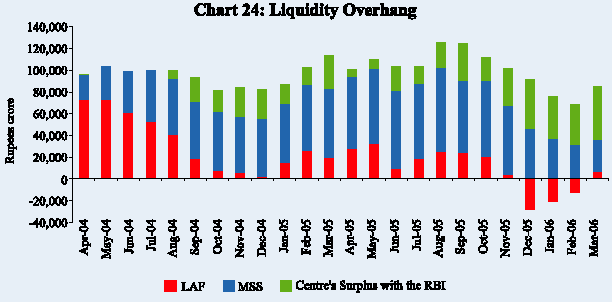
Liquidity conditions became tighter from mid-December 2005 due to IMD redemptions and build-up of Centre’s cash balances. To ensure smooth redemption of IMDs, the Reserve Bank sold foreign exchange of US $ 7.1 billion out of its foreign exchange reserves to the State Bank of India during December 27-29, 2005 against equivalent rupees (Rs.31,959 crore). On a review of the prevalent macroeconomic, monetary and liquidity conditions, including the redemptions of IMDs, the Reserve Bank decided on December 30, 2005 to suspend the issue of Treasury Bills and dated securities under the MSS. Consequently, between end-October 2005 and end-March 2006, there was an unwinding of balances held under the MSS (around Rs.40,690 crore). The Reserve Bank also injected liquidity
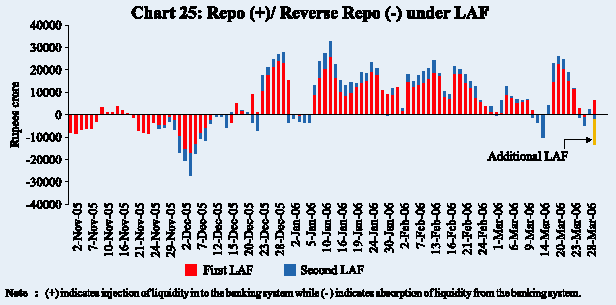
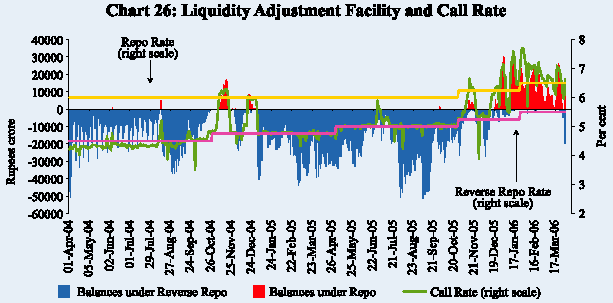
through repo operations (on a net basis) averaging Rs.15,386 crore during January 2006, Rs.13,532 crore during February 2006 and Rs.6,017 crore during March 2006 (Chart 26). Although call money rates edged above the repo rate during January-February 2006, the rates in the collateralised segment of the money market - market repos and Collateralised Borrowing and Lending Obligations (CBLO), which account for about 70 per cent of the market volumes - remained below the repo rate. Illustratively, in February 2006, when call rates had averaged 6.93 per cent, the average rates for market repo and CBLO at 6.41 per cent and 6.43 per cent, respectively, were well within the indicative reverse repo - repo rate corridor.
During March 2006, the private placement of dated Government securities (Rs.10,000 crore) with the Reserve Bank and the Reserve Bank’s forex operations in addition to LAF operations had a positive impact on the liquidity conditions. As a result, repo volumes under LAF declined in the first half of March 2006 and there was absorption of liquidity on a few occasions. Call money rates also started easing. In the third week of March 2006, some tightness in market liquidity was observed due to advance tax outflows and build-up of Centre’s surplus with the Reserve Bank. Liquidity conditions, however, improved during the last week of March 2006 and the LAF window witnessed net absorption of liquidity of Rs.7,250 crore as at end-March 2006. Call rates edged lower to below the repo rate. At the request of the market participants, the Reserve Bank conducted an additional LAF on March 31, 2006 between 9.00 p.m. to 9.30 p.m. to facilitate funds management by banks on account of the year-end closing on March 31, 2006 falling on a reporting Friday. Liquidity conditions improved further during April 2006 with liquidity absorption at Rs.49,690 crore as on April 12, 2006. Call rates eased further to 5.55 per cent on April 12, 2006.






















